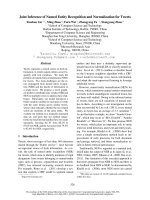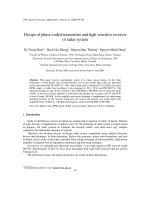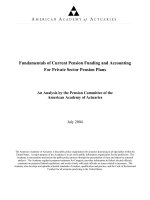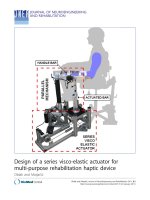Design of composite haunch beams and connections for long span applications
Bạn đang xem bản rút gọn của tài liệu. Xem và tải ngay bản đầy đủ của tài liệu tại đây (4.31 MB, 176 trang )
DESIGN OF COMPOSITE
HAUNCH BEAMS AND CONNECTIONS
FOR LONG SPAN APPLICATIONS
BY
NG YIAW HEONG (BEng.(Hons.), MEng)
DEPARTMENT OF CIVIL ENGINEERING
A THESIS SUBMITTED
FOR THE DEGREE OF DOCTOR OF PHILOSOPHY
NATIONAL UNIVERSITY of SINGAPORE
2004
ii
ACKNOWLEDGEMENTS
The author would like to take this opportunity to acknowledge various
individuals for their guidance and encouragement in the course of this research.
Firstly, the author would like to express his appreciation for the constant guidance and
encouragement provided by his research supervisors, Professor N.E. Shanmugam and
Associate Professor J.Y. Richard Liew. This research work would not have been
completed without their continuous support.
Secondly, the author is fortunate to have received moral support and
understanding from Sze Ching; his wife and his parents. He would like to express
gratitude to them. For the author’s 3 years-old and 1-year-old sons, Yan Zhang and
Ding Jie; the author could only apologize for not being able to keep them company
most of the time especially during the final stage of the study.
Last but not least, the assistance given by the lab officers during the
experimental testing in the Concrete and Structural Laboratory, National University of
Singapore is gratefully appreciated.
This research project was funded by the National University of Singapore
under a research grant (RP 930648). The support from Yongnam Engineering &
Construction Pte Ltd, Singapore who supplied the test specimens is gratefully
acknowledged.
iii
TABLE OF CONTENTS
TITLE PAGE i
ACKNOWLEDGEMENTS ii
TABLE OF CONTENTS iii
SUMMARY vi
LIST OF TABLES vii
LIST OF FIGURES xiii
LIST OF SYMBOLS xiv
CHAPTER 1 INTRODUCTION 1
1.1 BACKGROUND 1
1.2 RESEARCH OBJECTIVES 4
1.3 SCOPE OF WORK 5
1.4 STRUCTURE OF THE THESIS 6
CHAPTER 2 LITERATURE REVIEW 9
2.1 BACKGROUND 9
2.2 INTERNAL FORCES AND MOMENTS IN CONTINUOUS COMPOSITE HAUNCH BEAM 11
2.3 GLOBAL ELASTIC ANALYSIS OF NON-SWAY FRAME 12
2.4 PLASTIC HINGE ANALYSIS OF NON-SWAY FRAME 14
2.4.1 Rigid-Plastic Analysis 15
2.4.2 Elastic-Plastic Analysis 16
2.5 ANALYSIS OF HAUNCH SECTION 16
CHAPTER 3 EXPERIMENTAL INVESTIGATION
- HAUNCH CONNECTION 21
3.1 GENERAL 21
3.2 MATERIAL PROPERTIES 22
3.2.1 Beam and column sections 22
3.2.2 Reinforcement bar 23
3.2.3 Concrete 23
3.3 FABRICATION OF TEST SPECIMENS 24
3.4 TEST SET-UP 25
iv
3.5 INSTRUMENTATION 26
3.6 TESTING PROCEDURE 26
3.7 DATA ASSESSMENT 28
3.7.1 Beam rotation,
θ
b
28
3.7.2 Column rotation,
θ
c
28
3.7.3 Connection rotation,
φ
28
3.7.4 Inelastic Rotation,
θ
ie
29
3.8 JOINT STIFFNESS, R
KI
29
3.9 JOINT ULTIMATE MOMENT, M
U
29
3.10 JOINT ROTATIONAL CAPACITY, φ
CD
30
3.11 HAUNCH CONNECTION CAPACITY 30
3.12 HAUNCH TOE MOMENT CAPACITY 31
3.13 JOINT TEST RESULTS AND DISCUSSION 31
3.13.1 Comparison of test results 32
3.13.2 Connections H1 and H2 32
3.13.3 Connections H3 and H4 34
3.13.4 Connections H5 and H6 36
3.13.5 Connections H7 and H8 37
3.13.6 Connections H9 and H10 38
3.14 EFFECT OF SLAB REINFORCEMENT RATIO 40
3.15 EFFECTS OF HAUNCH LENGTH 40
3.16 CONCLUSIONS 41
CHAPTER 4 EXPERIMENTAL INVESTIGATION
- HAUNCH BEAM 59
4.1 INTRODUCTION 59
4.2 MATERIAL PROPERTIES 60
4.2.1 Beam and column sections 60
4.2.2 Reinforcement bar 61
4.2.3 Concrete 61
4.3 FABRICATION OF TEST SPECIMENS 61
4.4 TEST SET-UP 62
4.5 INSTRUMENTATION 65
4.6 TESTING PROCEDURE 65
4.7 BEAM TEST RESULTS AND DISCUSSION 66
4.7.1 Beam Specimen B1 66
4.7.2 Beam Specimen B2 69
4.7.3 Beam Specimen B3 71
4.8 CONCLUDING REMARKS 73
CHAPTER 5 ANALYTICAL MODEL 105
5.1 GENERAL 105
5.2 COMPARISON OF PLASTIC HINGE ANALYSIS AND TEST RESULTS 105
5.3 ROTATION CAPACITY 108
5.3.1 General 108
5.3.2 Calculation of available rotation capacity of composite section 109
5.4 BEAM ANALYSIS 111
5.4.1 Composite Haunch Beam Properties 111
5.4.2 Composite Haunch Beam analysis 115
5.5 FINITE ELEMENT MODELLING 116
5.5.1 Nonlinear Analysis Software: - USFOS 116
v
5.5.2 Modeling of Composite Haunch Beam 116
5.5.3 Results 117
5.6 LATERAL TORSIONAL INSTABILITY 117
5.6.1 General 117
5.6.2 Lateral Distorsional Buckling Design Method 118
CHAPTER 6 DESIGN RECOMMENDATIONS
AND DESIGN EXAMPLE 131
6.1 INTRODUCTION 131
6.2 DESIGN RECOMMENDATIONS 131
6.3 ELASTIC GLOBAL ANALYSIS 133
6.4 PLASTIC HINGE ANALYSIS 135
6.5 DESIGN PROCEDURE FLOW CHART 138
6.6 DESIGN EXAMPLE 140
CHAPTER 7 CONCLUSIONS AND
PROPOSALS FOR FUTURE WORK 141
7.1 GENERAL 141
7.2 BEHAVIOUR OF THE COMPOSITE HAUNCH CONNECTION 141
7.3 BEHAVIOUR OF THE COMPOSITE HAUNCH BEAM 142
7.4 SECTION PROPERTIES AND FRAME ANALYSIS 142
7.5 FUTURE WORK 144
APPENDIX A DESIGN EXAMPLE 146
REFERENCES 154
LIST OF PUBLICATIONS 160
vi
SUMMARY
This thesis is concerned with the behaviour of steel-concrete composite
haunch connections and beams. Experiments were carried out to investigate the
moment rotation characteristics and ultimate capacity of these connections and
beams. Details of the experiments giving information on test specimens,
instrumentation, test set-up and test procedures are described. There are a total
of 10 haunch connections and 3 continuous composite haunch beam specimens
tested to failure. Results obtained for connection moment capacity, rotation
capacity and failure modes are presented. It is found that through proper design
and detailing, these connections display the characteristics of a rigid connection.
Optimum design of composite haunch beam can be achieved when plastic hinge
occurred at haunch toes followed by at the mid-span to form a plastic collapse
mechanism. Haunch toe could be designed as the weakest section to form a
plastic hinge with suitable amount of reinforcement in the slab and range of
haunch length. Experimental results show that composite haunch connection
exhibits a ductile moment-rotation behaviour and is able to redistribute moment
to the mid-span by loss of stiffness due to cracking of concrete slab and yielding
of either steel reinforcement or cross section. Study also has been carried out to
investigate the parameters that influence the stiffness, strength and rotation
capacity of composite haunch connections. Design guidelines for composite
haunch joints and beams are provided.
vii
LIST OF TABLES
Chapter 2
Table 2.1 Limits to redistribution of hogging moment to reduce (EC4)
Table 2.2 Maximum redistribution of negative moment in composite haunch
beam at ultimate limit state [Lawson 1989]
Chapter 3
Table 3.1 Details of joint test specimens
Table 3.2 Summary of universal section properties and tensile test results
Table 3.3 Summary of reinforcement bar properties and tensile test results
Table 3.4 Summary of concrete cube test results
Table 3.5 Summary of test results
Chapter 4
Table 4.1 Summary of concrete cube test results for beam specimen
Table 4.2 Details of beam test specimens
Chapter 5
Table 5.1 Comparison of test results with Plastic Hinge Theory
Table 5.2 Comparison of rotational capacity at Haunch Toe
viii
LIST OF FIGURES
Chapter 1
Figure 1.1 Haunch as Taper Section in Universal Beam
Figure 1.2 Cutting of Taper Section in Universal Beam
Chapter 2
Figure 2.1 Cross Section of Continuous Composite Beam
Figure 2.2 Sub-frame of Beam and Column in Non-sway Frames Analysis
Figure 2.3 Relation between Haunch Beam Elastic Resistance and Parent Beam
Plastic Resistance
Figure 2.4 Distorsional Buckling of Composite Beam
Chapter 3
Figure 3.1 Building Plan Layout for Joint Specimens' Design
Figure 3.2 Cruciform Joint Specimen
Figure 3.3 Test Specimen Ready for Concrete Casting
Figure 3.4 Typical Joint Test Specimen
Figure 3.5 Joint Test Specimen Ready for Testing
Figure 3.6 Instrumentation of Test Specimen
Figure 3.7 Definition of Rotation in a Joint
Figure 3.8 Moment-rotation Curve of Connection
Figure 3.9 Stress-strain Block of Haunch Connection
Figure 3.10(a) View after Failure of Specimen H1 and H2
Figure 3.10(b) View after Failure of Tension Bolt of Specimen H1 and H2
ix
Figure 3.11 Moment-Rotation Curve of H1 and H2
Figure 3.12 View after Failure of H3 and H4
Figure 3.13 Moment-Rotation Curve of H3
Figure 3.13 Moment-Rotation Curve of H4
Figure 3.15 View after Failure of H5
Figure 3.16 Moment-Rotation Curve of H5
Figure 3.17 View after Failure of H6
Figure 3.18 Moment-Rotation Curve of H6
Figure 3.19 View after Failure of H7
Figure 3.20 Moment-Rotation Curve of H7
Figure 3.21 View after Failure of H8
Figure 3.21 Moment-Rotation Curve of H8
Figure 3.23 View after Failure of H9
Figure 3.24 Moment-Rotation Curve of H9
Figure 3.25 Premature Failure of H10
Figure 3.26 Comparison of Load-Displacement Curve of H2,H4 and H6
Figure 3.27 Comparison of Load-Displacement Curve of H3, H4, H7 and H8
Chapter 4
Figure 4.1 Haunch Beam Test Specimen
Figure 4.2 Wooden Formwork of Beam Test Specimen
Figure 4.3 Beam Specimen Ready for Concrete Casting
Figure 4.4 Beam Specimen Ready for Testing
Figure 4.5 Isometric View of Haunch Beam Test Specimen
x
Figure 4.6 Schematic Loading of Haunch Beam Test Specimen
Figure 4.7 Loading Frame in Haunch Beam Test Specimen
Figure 4.8 Loading Frame Connected to Hydraulic Actuator
Figure 4.9 Larger Haunch Connection at Cantilever Beam Side
Figure 4.10 Instrumentation of Beam Specimen
Figure 4.11 View after Failure of Specimen B1
Figure 4.12 Load-Displacement Curve of Specimen B1
Figure 4.13 Inelastic Buckling in Compression Flange of the Beam B1
Figure 4.14 Crushing of Concrete Slab at Loading Point in Beam B1
Figure 4.15 Concrete Slab Cracking Pattern of the Beam B1 at Haunch Toe
Figure 4.16 Strain Reading of Cross Section for Beam B1 at Left Haunch Toe at
Different Load Stage
Figure 4.17 Strain Reading of Cross Section for Beam B1 at Right Haunch Toe at
Different Load Stage
Figure 4.18 Strain Reading of Cross Section for Beam B1 at Left Loading Point at
Different Load Stage
Figure 4.19 Strain Reading of Cross Section for Beam B1 at Right Loading Point at
Different Load Stage
Figure 4.20 Strain Reading of Tension Reinforcement for Beam B1 at Left
Haunch Toe at Different Load Stage
Figure 4.21 Strain Reading of Tension Reinforcement for Beam B1 at Right
Haunch Toe at Different Load Stage
Figure 4.22 Strain Reading of Concrete Slab for Beam B1 at Left Loading Point at
Different Load Stage
Figure 4.23 Strain Reading of Concrete Slab for Beam B1 at Right Loading Point
at Different Load Stage
Figure 4.24 Load-Displacement Curve of Specimen B2
Figure 4.25 Inelastic Buckling of Compression Flange of the Beam B2
Figure 4.26 Crushing of Concrete Slab at Loading Point in Beam B2
xi
Figure 4.27 Strain Reading of Cross Section for Beam B2 at Left Haunch Toe at
Different Load Stage
Figure 4.28 Strain Reading of Cross Section for Beam B2 at Right Haunch Toe at
Different Load Stage
Figure 4.29 Strain Reading of Cross Section for Beam B2 at Left Loading Point at
Different Load Stage
Figure 4.30 Strain Reading of Cross Section for Beam B2 at Right Loading Point at
Different Load Stage
Figure 4.31 Strain Reading of Tension Reinforcement for Beam B2 at Left
Haunch Toe at Different Load Stage
Figure 4.32 Strain Reading of Tension Reinforcement for Beam B2 at Right
Haunch Toe at Different Load Stage
Figure 4.33 Strain Reading of Concrete Slab for Beam B2 at Left Loading Point at
Different Load Stage
Figure 4.34 Strain Reading of Concrete Slab for Beam B2 at Right Loading Point
at Different Load Stage
Figure 4.35 Load-Displacement Curve of Specimen B3
Figure 4.36 View after Failure of Specimen B3
Figure 4.37 Inelastic Buckling of Left Haunch Flange of the Beam B3
Figure 4.38 Inelastic Buckling of Right Haunch Flange of the Beam B3
Figure 4.39 Crushing of Concrete Slab at Loading Point in Beam B3
Figure 4.40 Strain Reading of Cross Section for Beam B3 at Left Haunch Toe at
Different Load Stage
Figure 4.41 Strain Reading of Cross Section for Beam B3 at Right Haunch Toe at
Different Load Stage
Figure 4.42 Strain Reading of Cross Section for Beam B3 at Right Haunch Heel at
Different Load Stage
Figure 4.43 Strain Reading of Cross Section for Beam B3 at Left Haunch Heel at
Different Load Stage
Figure 4.44 Strain Reading of Cross Section for Beam B3 at Left Loading Point at
Different Load Stage
xii
Figure 4.45 Strain Reading of Cross Section for Beam B3 at Right Loading Point at
Different Load Stage
Figure 4.46 Strain Reading of Tension Reinforcement for Beam B3 at Left
Haunch Toe at Different Load Stage
Figure 4.47 Strain Reading of Tension Reinforcement for Beam B3 at Right
Haunch Toe at Different Load Stage
Figure 4.48 Strain Reading of Concrete Slab for Beam B3 at Left Loading Point at
Different Load Stage
Figure 4.49 Strain Reading of Concrete Slab for Beam B3 at Right Loading Point
at Different Load Stage
Figure 4.50 Comparison of Load-Displacement Curve for Specimens B1, B2 and
B3
Chapter 5
Figure 5.1(a) Haunch Beam with 2 Point Loads
Figure 5.1(b) Collapse Mechanism in Haunch Beam
Figure 5.1(c) Moment Diagram of 2 Point Loads
Figure 5.1(d) Moment Diagram of Haunch Toe Loads
Figure 5.1(e) Moment Diagram of 2 Point Loads and Haunch Toe Loads
Figure 5.2 Moment-Rotation Curve according to Kemp, (1991)
Figure 5.3 Plastic Region near the Internal Support of Continuous Beam
Figure 5.4 Bi-Linear Moment-Rotation Curve for Connection H3
Figure 5.5 Bi-Linear Moment-Rotation Curve for Connection H4
Figure 5.6 Bi-Linear Moment-Rotation Curve for Connection H5
Figure 5.7 Bi-Linear Moment-Rotation Curve for Connection H6
Figure 5.8 Bi-Linear Moment-Rotation Curve for Connection H7
Figure 5.9 Bi-Linear Moment-Rotation Curve for Connection H9
Figure 5.10 Cross Section of Haunch Beam with PNA at Beam Flange
xiii
Figure 5.11 Cross Section of Haunch Beam with PNA at Beam Web
Figure 5.12 Modeling of Haunch Beam in Finite Element Software USFOS
Figure 5.13 Comparison of USFOS and Experimental Load-Displacement Curves
for Beam B1
Figure 5.14 Comparison of USFOS and Experimental Load-Displacement Curves
for Beam B1
Figure 5.15 Comparison of USFOS and Experimental Load-Displacement Curves
for Beam B1
xiv
LIST OF SYMBOLS
A = Section area
A
f
= Flange area
A
w
= Web area = A - 2A
f
B = Beam Width
B
e
= Concrete effective width
D = Diameter
D = Beam Depth
D
h
= Depth of Haunch
E1 = Strain energy absorbed in lateral bending of the bottom flange
E2 = Torsional energy absorbed in twisting the bottom flange
E3 = Bending energy absorbed in displacing the web
E4 = Torsional energy absorbed in twisting the web
E5 = Work done by the compressive force in the bottom flange
E6 = Work done by the forces in the web
φ
= Connection rotation
φ
a
= Inelastic available rotation
φ
C
= Parameter I
c
L/(I
bc
h)
φ
Cd
= Joint rotational capacity
f
cu
= Concrete Compressive Strength
φ
e
= Required Elastic rotation
FEM = Fixed-ended moment of the beam under the same loading condition
φ
r
= Required Inelastic rotation
f
u
= Steel Ultimate strength
u
= Rotational capacity
f
uf
= Ultimate strength of flange
xv
f
ur
= Rebar Ultimate strength
f
uw
= Ultimate strength of web
f
y
= Steel Yield strength
f
yf
= Yield strength of flange
f
yr
= Rebar Yield strength
f
yw
= Yield strength of web
γ
mr
= Partial material factor
h = Length of column from floor to floor
η
LT
=
Perry Coefficient
I
bc
= Second moment of area of the uncracked composite beam
I
c
= Second moment of area of the column
L = Length of the beam (including the haunch)
λ
= Slenderness of the beam length between restraints
L = Length between hinges at both ends
L
e
= Span of the beam between the end of the haunches
L
i
= Length between maximum moment and adjacent point of inflection
λ
LT
= Equivalent Slenderness
L
p
= Plastic region of the flange
M
he
= Elastic Moment Resistance of Haunch Section
M
hu
= Moment capacity of composite haunch connection
M
n
= Negative moment
M
nc
= Negative moment resistance of the composite beam
M
p
= Design moment resistance
M
pc
= Positive moment resistance of the composite beam
M
ph
= Plastic moment capacity of hogging region
M
ps
= Plastic moment capacity of sagging region
M
s
= Elastic Moment Resistance of Steel Beam Section
xvi
M
u
= Moment resistance
n = Slenderness correction factor (for shape of bending moment diagram)
P = Point Load
p
y
= Design strength for steel
θ
b
= Beam rotation
θ
c
= Column rotation
θ
ie
= Inelastic rotation
r
a
=
available rotational capacity φ
a
/
φ
e
(Non-dimension)
R
b
= Bolt in tension
R
hf
= Haunch flange capacity
R
hw
= Haunch web capacity
R
ki
= Joint stiffness
R
ki
= Rotational stiffness
R
r
= Reinforcement in tension
r
r
=
Required rotation capacity φ
r
/
φ
e
(Non-dimension)
T
hf
= Thickness of haunch flange
t
hw
= Thickness of haunch web
u = Buckling parameter (0.9 for universal sections)
v
t
= Slenderness factor (including torsional stiffness and other effects).
w
u
= Factored design load on the beam
y
c
= Distance from the top of haunch flange
1
CHAPTER 1
INTRODUCTION
1.1 Background
Composite structures comprising of steel frames and concrete floors were
introduced in the last century and are now commonly used in modern buildings. These
kinds of construction method are widely used now because of structural economy
with fast speed of construction. Interaction between steel and concrete is achieved by
connecting them by means of shear connectors. Metal decking may be used as
permanent formwork to support any load during construction and later to act
compositely with the hardened concrete slab to form a composite slab.
There are a number of advantages in using composite beams. Firstly, the
total steel weight reduces significantly by 30 to 50 % compared with non-composite
beams (Narayanan, 1991, Lawson, 1995, Uy & Liew, 2003). Composite beams also
provide larger stiffness that will reduce the depth of the beam for the same span. This
results in lower storey heights and savings in cladding costs or, alternatively,
permitting more headroom for services. Another benefit of composite construction is
the metal decking which supports construction loads and acts as a working platform.
The decking also acts as transverse reinforcement to the composite beams and
distributes shrinkage strains and prevents serious cracking of concrete.
Besides the advantages mentioned above, a strong demand for large column-
free space in buildings in recent times has necessitated further research into the
behaviour of haunch beams since they are considered to be an efficient and
economical form for long span construction. This system is able to offer more variety
to the designer in planning the usage of the column-free space. There are several
types of structural options for achieving long span and incorporating of services
within normal floor zones. These include (Lawson and Rackham, 1989, Owen, 2000):
i) Beams with web openings
ii) Castellated beams
2
iii) Fabricated beams with tapered web
iv) Trusses
v) Stub girders
vi) Parallel beam grillage systems
vii) Haunch beams
Haunch beams in this thesis are defined as beams being stiffened at two ends
with a tapered triangular T-Section as shown in Fig.1.1. The tapered section is usually
cut from a similar section. Fig.1.2 shows two typical tapered sections being cut from a
universal beam. These tapered sections will then be welded to the beam ends and
usually there are end plates at both ends of the beam as shown in the diagram.
Haunch beams are designed by assuming a rigid moment connection between
the beams and columns. Depth and length of a haunch are chosen so that they result in
an economical method of transferring moment into the column and in a reduction of
beam depth to a practical minimum. Haunch composite beams in which steel beams
are designed to act in conjunction with a concrete slab of definite width could result in
shallow beams, provide sufficient rotation capacity of the connection that will permit
a redistribution of the moment and thus mobilise a full sagging capacity of the beam
resulting in an economical design. Furthermore, haunch beam systems could also
provide a long unobstructed space for services and increase speed of construction.
One of the common scenarios in steel construction is opening for services. Usually
web of the steel beam need various sizes of penetration for mechanical and electrical
services. Those penetrations normally are required to be strengthened by extra
stiffeners which directly increase the fabrication cost. Therefore, it is not cost
effective to create openings unless really there are no other choices. However, with
the haunch beam system, the space at the haunch region could offer more freedom for
3
Mechanical & Electrical services and less co-ordination between the steel contractor
and the M&E engineers during the construction stage. This will definitely increase the
production of steelwork and indirectly increase the construction speed.
Haunch composite beams may offer continuity at the beam-column support
and hence increase the structural performance of the system as a continuous beam. A
continuous beam could offer about 33% of strength compared with a simply
supported beam system. The continuity in composite beams provides benefits at both
the ultimate and serviceability limit states for long span structures. For instance, the
deflection of the beam could be easily 50% less for a continuous beam compared with
the simply supported beam system. However, one of the shortcomings in continuous
composite beams is that the composite sagging section capacity is always larger than
the hogging moment. For a continuous composite beam such as a parallel beam
grillage system, the negative bending at internal supports is generally significantly
less than the resistance in positive bending in the midspan region. Therefore, the
introduction of a haunch may be an option to overcome the shortcoming because it
will increase the hogging section capacity. And if necessary, tension reinforcement
could be added thus increasing the hogging capacity. Test results show that the
hogging capacity is as high as the sagging section capacity when sufficient tension
reinforcement is placed at the concrete slab at the hogging region. The ultimate
strength of composite beams under sagging moment has been well established and
Eurocode 4 has offered detailed design guideline. However, under hogging moment,
many tests have been conducted (Hamada 1976) and the results have shown that the
majority of beams failed as a result of local buckling. Tests have shown that the
width-thickness ratio for the flange of the steel section and the amount of longitudinal
slab reinforcement are significant factors affect local flange buckling. Therefore, it is
4
important to find out the factors that affect the design of haunched composite beams
so that the structural system will be utilised more efficiently.
Eurocode 4 defines composite connection as the one, which the reinforcement
in the joint is intended to provide resistance in tension. The tensile action of the slab
reinforcement increases both the resistance and stiffness compared with the structural
steel connection. However, the connections will usually be partial-strength
connections relative to the composite section next to the connection. Therefore,
haunches could be introduced to provide full continuity, which strengthens the
connection between the steel sections. For economy in composite beam design, both
the hogging end resistance and the mid-span sagging resistance should be well utilised
as it will be shown in the proposed experimental program that the hogging and
sagging resistance of the composite haunch beam can be proportioned to achieve an
optimum design. It is also noticed that by introducing the haunch in the steel
connection, the rotational capacity at the joint is almost not required because both the
hogging and sagging section capacity are reached at the same time. The philosophy of
this design concept is that the ductility (i.e. rotation capacity) is no longer important if
the hogging and sagging section capacity is achieved simultaneously. This is unlike
the composite joint without haunch which requires that they have both sufficient
strength and ductility. In addition, the connection moment capacity should be greater
than the applied moment, and the connection capacity should be larger than that
required to develop the moments in the beam at the ultimate limit state.
1.2 Research Objectives
The main objective of this research is to study experimentally the behaviour of
composite haunch connections and composite haunch beams with tension
5
reinforcement subjected to negative moment condition in order to simulate the joint in
non-sway composite frames. Parameters such as reinforcement ratio and haunch
length are varied in the experimental program. The effects of these parameters with
respect to moment capacity, rotational stiffness, rotation capacity are studied. The
results will be used to develop analytical and design guidelines for composite haunch
beams. The key joint properties, i.e. moment resistance M
u
, rotational capacity
u
,
rotational stiffness K
i
are evaluated for global frame analysis.
1.3 Scope of works
In this thesis, literature related to composite haunch connections and
composite haunch beams are reviewed. The scope of literature study is not only
limited to haunch connections. Non-haunch connections were also studied and
comparisons made between haunch and non-haunch composite connections.
A series of composite haunch connections and composite continuous haunch
beams were tested to failure in the laboratory. All the experimental results are
reported in detail. The experimental study also includes the behaviour of the
composite haunch connection and haunch beam illustrated by their moment-rotation
curves. The effects of parameters such as reinforcement ratio, haunch length and the
moment-rotation curve are investigated.
Analytical models for the prediction of moment resistance M
u
, rotational
capacity
u
and rotational stiffness K
i
of the composite haunch beam are established.
Results obtained from experiments are compared against the analytical model. And
finally, design guidelines for composite haunch beam are provided.
6
1.4 Structure of the Thesis
The thesis contains seven chapters. Chapter 1 gives the general description of
the advantages of composite construction and in particular composite haunch beam
construction. The need for further research on composite haunch beam construction in
long span application is presented and the objectives and scope of the research are
highlighted in the chapter.
Chapter 2 reviews the literature on haunch beam construction; both
experimental and analytical studies for braced and sway frame since 1972 are
covered. Various types of constructions other than haunch beam constructions are also
studied here and the pros and cons of these construction methods are presented. This
chapter also describes different types of analyses for composite haunch beams.
Considering the studies carried out by the previous researchers, the direction for the
present study is illustrated.
Chapter 3 describes the experimental program for haunch connections in non-
sway composite frames. Details of the test set-up and parameters varied in the
investigation are given. Materials for the test specimens with their mechanical test
results is presented here. This chapter also explains the loading procedure for the
testing. Test results obtained from the experiments is also presented which includes
the beam behaviour from the initial stage to the ultimate stage. The actual behaviour
of composite haunch connections is discussed systematically by comparing among the
test specimens. Failure modes of those specimens are identified and the effects of the
parameters illustrated.
Chapter 4 describes the experimental program for haunch beam construction.
Three composite haunch beam specimens of 8m span were tested to failure. Details of
the test set-up and the parameters varied in the experimental program are given.
7
Besides, this chapter explains the loading procedure for the beam testing. Test results
obtained from the experiments are presented covering the response behaviour from
the initial load stage to the ultimate load stage. The actual behaviour of composite
haunch connections is discussed by comparing among the test specimens. Failure
modes of those specimens are identified and the effects of the key design parameters
are illustrated.
Chapter 5 presents analytical models to predict the moment capacities,
rotational capacity and initial stiffness of composite haunch connections. The results
obtained in the experimental program are compared with those obtained using the
analytical models proposed, thus verifying the models. In addition, non-linear finite
element analysis is used to confirm further the experimental results and analytical
model.
Chapter 6 presents design recommendations and an example for the composite
haunch construction. Conclusions and recommendations for future research are given
in Chapter 7.
8
Fig. 1.1 Haunch as Tapered Section in Universal Beam
Fig.1.2 Cutting of Tapered Section in Universal Beam
Universal beam
Universal Column
Tapered Section
Tapered Section
Tapered Section
Cutting Line
Universal Beam
9
CHAPTER 2
LITERATURE REVIEW
2.1 Background
Researchers (Aribert and Raoul, 1992, Cosenza et al., 1995a, Climenhaga and
Johnson, 1972a, Couchman, 1996, Dekker et al., 1995, Fabbrocino et al., 2001,
Hamada and Longworth, 1976, Hamada and Longworth, 1974, Hope-Gill and
Johnson, 1976, Johnson and Chen, 1991, Kemp and Dekker, 1991, Leon, 1990, Liew
et al., 2001, Lukey and Adams, 1969, Price and Anderson, 1992, Tehami, 1997) have
proposed design methods for simple or continuous composite beams, the cross section
of which is as shown in Fig. 2.1. Required and available rotation capacities for the
section have been considered and the accuracy of the prediction method has been
assessed by comparing the theoretical and experimental results. Research works
referred above comment on the composite beam behaviour but seldom consider the
sub-assemblies of composite frame. Early work by Kitipornchai and Trahair, 1972 has
shown that uniform beams are not always the most efficient choice and often great
material economy can be achieved by using non-uniform beams such as haunch beam.
The research work reported herein is to incorporate composite haunch connection as
the joint in a sub-assembly. Unlike the ‘Reduced Beam Section’ (often referred to as
‘dogbone’ (Plumier, 1997)) which is accomplished through an engineered gradual
transition of the beam flanges to the intended reduced section at a given location, the
haunch connection strengthens the connection and allows the formation of plastic
hinges at a designated location (Iwankiw, 1997). Haunch composite beams are
designed in a similar manner to continuous beams of uniform section (Lawson and
Rackham, 1989). The critical section for design is at the haunch toe, and the depth of









